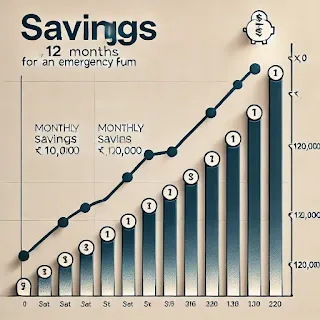Introduction: Why You Need an Emergency Fund
An emergency fund is one of the most important pillars of personal finance. It’s a safety net designed to cover unforeseen expenses such as medical bills, car repairs, or unexpected job loss. Without this financial cushion, you might end up relying on high-interest credit cards or loans, leading to a cycle of debt.
In this blog, we'll discuss why an emergency fund is crucial for everyone, who should prioritize it, and how to start building it today. We'll also provide some practical examples and images to illustrate these points.
Why Is an Emergency Fund Crucial?
Financial Security Life is full of unexpected events, and an emergency fund ensures you can handle these without disrupting your financial stability. Whether it's a sudden illness or home repair, having a buffer prevents you from derailing your long-term financial goals.
Debt Prevention An emergency fund prevents the need for borrowing in case of urgent expenses. Without one, you might have to take on credit card debt or personal loans with high interest rates. Over time, these debts can accumulate and make it difficult to achieve financial independence.
Peace of Mind Knowing you have funds to cover emergencies reduces stress and anxiety. This peace of mind lets you focus on other aspects of life, such as growing wealth or planning for future financial goals.
Who Should Build an Emergency Fund?
Everyone—regardless of their income, job stability, or lifestyle, having an emergency fund is essential.
- College Students: Even students should have some funds set aside for emergencies like car repairs, medical expenses, or unexpected tuition hikes.
- Young Professionals: Individuals just starting their careers should aim to build an emergency fund, especially if they live independently or have variable incomes.
- Families: For households, especially those with children, an emergency fund is critical for covering unforeseen family expenses.
- Retirees: Even retired need an emergency fund to manage unexpected healthcare or home maintenance costs.
How Much Should You Save?
A general rule of thumb is to save 3 to 6 months of living expenses. This means that if your monthly expenses are ₹40,000, you should aim to have between ₹1,20,000 and ₹2,40,000 in your emergency fund.
Step 1: Calculate your essential monthly expenses:
- Rent or mortgage
- Utilities (electricity, water, gas)
- Groceries
- Loan or credit card payments
- Transportation
- Insurance (health, car, etc.)
Step 2: Multiply the total by 3 to 6 months to determine your emergency fund target.
Example: If your essential monthly expenses are ₹30,000, your emergency fund goal should be between ₹90,000 and ₹1,80,000.
How to Build an Emergency Fund: Step-by-Step
Set a Realistic Goal
Start with a smaller, more manageable target, such as ₹10,000, and gradually build from there. This helps you stay motivated and avoid feeling overwhelmed.Automate Your Savings
One of the easiest ways to build an emergency fund is to automate savings. Set up a recurring transfer from your salary account to a dedicated savings account. Even ₹2,000 a month adds up over time.Cut Unnecessary Expenses
Identify non-essential expenses, such as dining out or subscriptions, and temporarily reduce them. Allocate this saved money towards your emergency fund.Earn Extra Income
Consider side jobs, freelance work, or selling unused items to boost your emergency savings.
Example of Building an Emergency Fund
Let’s say you’ve decided to save ₹1,20,000 over the next 12 months. To achieve this, you would need to save ₹10,000 per month. You can break this down further by cutting discretionary expenses or increasing your income to meet the monthly target.
Image Example: A graph showing savings progression from ₹0 to ₹1,20,000 over 12 months.
Where to Keep Your Emergency Fund
Your emergency fund should be kept in a liquid, accessible account. Here are a few options:
- High-Interest Savings Account: Provides easy access to funds while earning interest.
- Money Market Account: Another safe and liquid option with a slightly higher interest rate than a regular savings account.
- Liquid Mutual Funds: For slightly better returns than savings accounts, you can park your emergency fund in liquid mutual funds. Just ensure they are easily redeemable without penalties.
Conclusion
Building an emergency fund is the first and most crucial step towards financial stability. Start small, automate your savings, and ensure that the funds are easily accessible. This financial safety net will protect you from falling into debt and help you maintain peace of mind during life's unpredictable events.
If you're ready to start building your emergency fund, subscribe to our blog for more practical tips on managing your personal finances. Let us guide you step-by-step to financial independence!
Learn how to set financial goals that help you plan for short, medium, and long-term success in our next post.



No comments:
Post a Comment